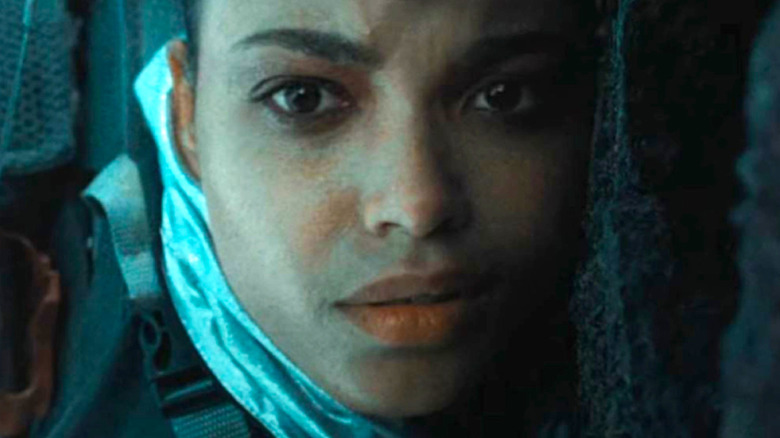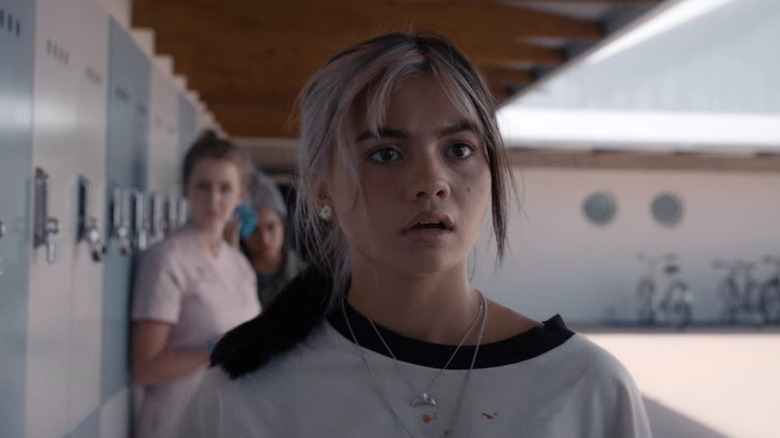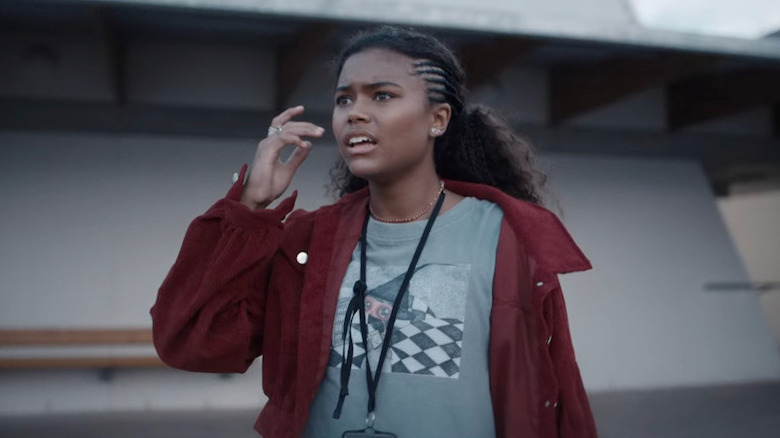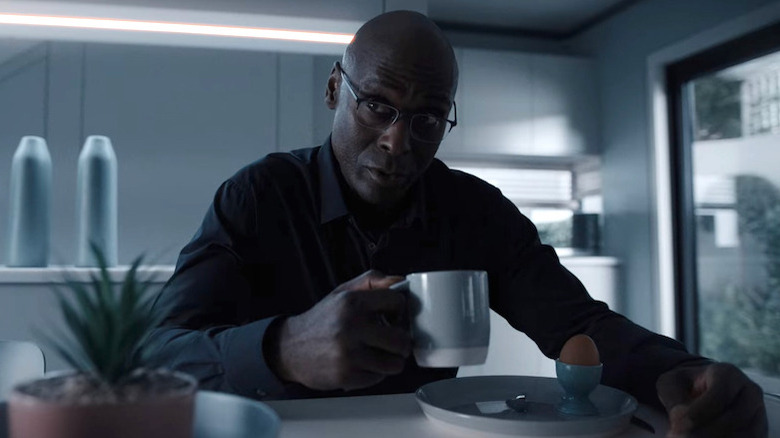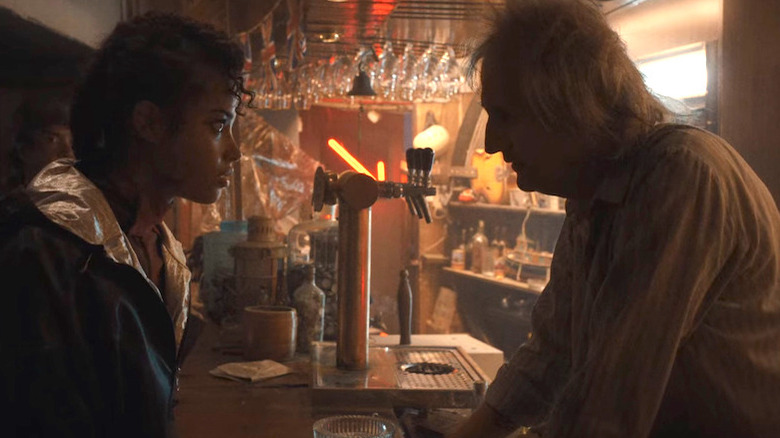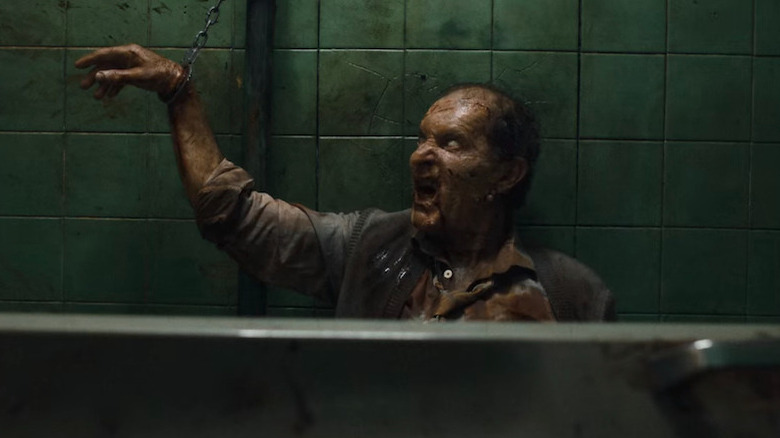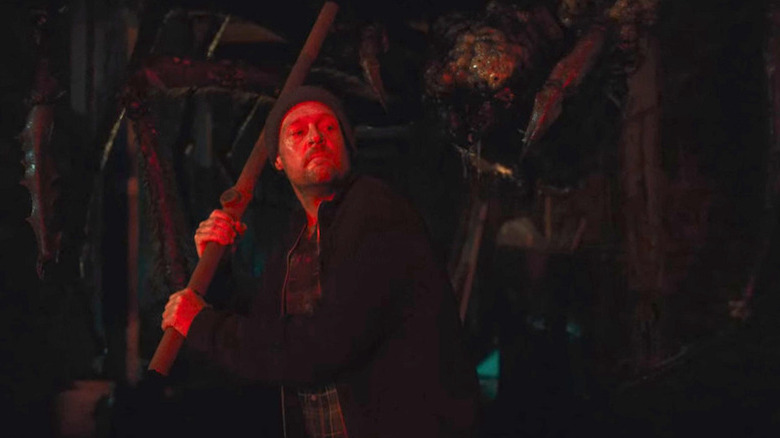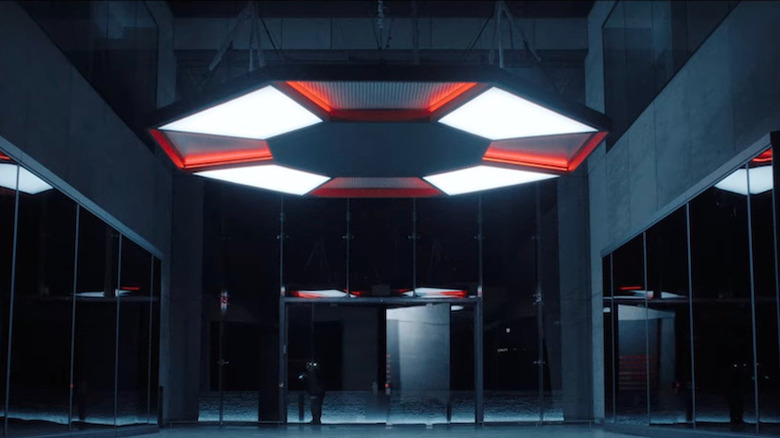Every Mistake Netflix Made With Resident Evil Ranked
Contains spoilers for "Resident Evil"
In the world of horror video games, "Resident Evil" is arguably the prestige name when it comes to scaring gamers silly with zombies, werewolves, and giant vampire women. But Screen Gems and Sony Pictures quickly realized the franchise's potential way back in the early 2000s, tapping Paul W. S. Anderson to bring it to life on the big screen in 2002's "Resident Evil." The timeline of the Milla Jovovich-starring franchise deviated far away from the games, but still delivered a high-octane science-fiction horror experience that many filmgoers enjoyed, until it ended with "Resident Evil: The Final Chapter" in 2016.
Since then, many have wondered what the franchise could look like in a time after the rise of so-called "elevated horror" of the mid 2010s, and now Netflix has tried its hand at turning the games into a bingeable series. 2022's "Resident Evil" follows Jade Wesker (Tamara Smart) and Billie Wesker (Siena Agudong) as they move to New Raccoon City with their father, Albert Wesker (Lance Reddick) — who has taken a job at Umbrella Corporation's South African base. Unfortunately, it isn't long before the twins start looking into the secrets lurking beneath the company's squeaky-clean exterior and inevitably unleash a flesh-eating apocalypse.
Unfortunately, the series quickly earned itself a handful of middling reviews alongside a weak 59% rating on Rotten Tomatoes before it arrived on the streaming service. It's a complete misfire from Netflix, which is even more disappointing when you consider the streamer's other horror offerings. Here's everything the series got wrong, in one fell swoop.
The tone is all over the place
One of the most jarring aspects of the series is the fact that it's also a teen drama. Yes, you read that right — Netflix managed to inject some of that "Riverdale" flavor into "Resident Evil." Unfortunately, nobody needs "RiverdEvil." Nobody. There's nothing wrong with telling a story over the course of two separate timelines of course, because it can be very effective when done properly. But when the 2022 series flicks to young Jade (Tamara Smart) and Billie Wesker (Siena Agudong) dealing with a bully at school, it's hard not to feel cheated out of what could have been something special.
That's not to say the pre-apocalypse timeline is completely terrible — the Umbrella Corporation conspiracy offers some nods to the original Raccoon City — but it just feels limp next to the post-apocalypse segments. Who cares if Billie is getting bullied by the locals? There are mutant dogs hidden in secret laboratories, focus on that! It's infuriating, especially when most of the games and films are set after the world has gone to the zombies.
The post-apocalypse world keeps the pace up with plenty of mindless action scenes — but Netflix are going to have some hospital bills to fork out for thanks to the inevitable whiplash claims. The clashing tones are unbelievably jarring when it jumps from high school shenanigans to seeing Jade on the run from Umbrella through zombie-infested wasteland. Point blank, "Resident Evil" tries to do too much.
Resident Evil has the worst sister relationship ever
Weirdly, much like the beloved petrol-soaked cinematic saga "The Fast and the Furious," the "Resident Evil" franchise in all its various forms has been about family. Between the occasional mutilated corpse wandering about the place, some of the most beloved installments have focused on siblings Chris and Claire Redfield or even a murderous family on the opposing side. With that in mind, it would make sense, from a narrative standpoint, to have a familial bond running through TV show, as well, to help the story along. It's too bad, then, that the one here is anything but interesting ... and the sisters in this show go together like zombies at a vegan buffet.
Siena Agudong and Tamara Smart as Billie and Jade Wesker certainly have the acting chops, but they are given nothing to put them to the test. It's all due to their respective characters having questionable motivations to begin with, and then making even more bizarre decisions that lead to them growing apart. While Billie being bitten and going through the T-virus change is intended to conjure some friction, it fails simply because these two never felt like a solid pair to start with. Jade is the toughest of the two, but never really comes to Billie's aid when she needs her — throwing shade, rather than fists, at a school bully who is begging for a beatdown. As for the eventually bitter, bitten sister, Billie (there's a cool band name), seeing her become even more angsty than she already is makes her even more unlikeable. Teenagers can be a test to begin with, but one infected with a planet-wrecking virus is even worse. We sure do miss the Redfields.
No character acts like a normal human being
"No, don't go there! That's the wrong door."
"No one asked you to pick that up."
"Up the ladder! What are you going down for?"
These are just a handful of some of the war cries fans of the "Resident Evil" franchise had screamed at their screens, over the years, when pixelated organ munchers were chasing the likes of Leon Kennedy or the Redfield siblings. Of course, these actions are slightly permissible in a video game format (mainly because the player is partly responsible for them happening). Even so, that doesn't warrant these buggy issues transferring over to the characters of the latest live-action iteration — because here, it simply paints them all as absolute morons.
There are moments in Netflix's "Resident Evil" where characters show a level of stupidity that's borderline offensive, detaching you further from their world and the airheads in it. One standout moment is seeing young Billie Wesker (Siena Agudong) come across a sealed black container storing something that's not in the best mood, whereupon she decides that opening it is perfectly acceptable. It's not. Instead, it's used as a plot device for Billie to be bitten by the diseased dog she has set loose, setting off a chain reaction of other people making equally idiotic decisions.
If it's not Albert barely monitoring his daughter after being bitten by an undead Doberman, it's no one at her school noticing she's turned paler than out-of-date milk. Honestly, just because these people are in a world based on a video game doesn't mean they have to act like it.
Wasting Lance Reddick is criminal
While the critical success rate for "Resident Evil" on anything outside a loading screen hasn't been that great, there's no denying some of the impressive talents the previous live-action iterations somehow managed to pull in. The likes of Oded Fehr, Jarred Harris, and Colin Salmon (right up until his epic death scene) all played their part, but deserved so much more. And now, Netflix's go at the game series has fallen into a similar hole with its biggest star.
Lance Reddick did not police the tough streets of "The Wire" or fight fire with fire alongside "John Wick" to be given this iffy iteration of Albert Wesker. The iconic villain from "Resident Evil" that was all about infecting the world — and looking cool doing so — is reimagined here as another mild-mannered scientist playing God, when he's not just being a terrible father. While it's a brave twist on the villain we know, it demands very little of Reddick, who takes on a role that anyone could handle.
Reddick dominates one scene during a visit to the school principal's office, but it still feels like part of a role far below his stature. In a series about zombies, lickers, and giant spiders, one of the biggest horrors is having an actor of this caliber wasted to this degree. Reddick is better than this. We just wish the show was the same.
It's scary how cheap this looks
Unfortunately, all of the issues are only amplified by how cheap "Resident Evil" looks, visually. To be fair, the zombie prosthetics, the gore, and the visual effects are well done, but that's the base level that a "Resident Evil" show should be hitting regardless of when and where it takes place. New Raccoon City and its high school looks like Netflix has rocked up to a holiday resort and thrown a few Umbrella posters up just to convince audiences they really are watching something related to the iconic franchise. It also doesn't have much style either — even in the post-apocalypse. As Jade tries to get home, she travels through the Brighton stronghold and eventually makes her way to France via an underground trafficking route. These bases are basically copied and pasted from the likes of "Mad Max," "The Matrix," any of the "Terminator" movies, or any of the numerous other post-apocalyptic movies out there in a generic "Hey, look, it's the end of the world as we know it" approach.
Speaking of that trafficking route, it should be one of the most harrowing scenes of the series, as innocent people try and make their way through the channel tunnel, which is unfortunately infested with Lickers, giant spiders, and zombies. Instead, most of the threats are shrouded in darkness — and any tension is completely undercut by gun-toting goons using these monsters as bullet sponges. It's possible the cheap set design and poor lighting is a way of saving money for the visual effects, but the sequence is definitely worse off for it.
If Netflix had let its directors and cinematographers use a bit more flair in these moments, the channel tunnel scene could've been something truly special. Instead, it's a lifeless means-to-an-end of getting Jade into France. Yawn.
It has an all-too-familiar bite of other zombie movies
After George A. Romero's "Night of the Living Dead" reshaped horror tropes forever, and established zombies as a terrifying presence in pop culture, there have been a few attempts to freshen up the flesh-eaters in a way that directly parallels horrors in the modern world. Danny Boyle invigorated the classic zombie by turning them into screaming, sprinting hordes of infected in "28 Days Later" and its sequel "28 Weeks Later." Zack Snyder followed suit with a similarly brutal approach in his "Dawn of the Dead" remake.
While the "Resident Evil" games offer fans a uniquely terrifying experience at home, the Netflix series is just too derivative for its own good.
Hell, it kicks off with an older Jade Wesker (Ella Balinska) in post-apocalyptic London on the ruins of Westminster Bridge doing her best impression of Jim (Cillian Murphy) in the iconic "28 Days Later" scene set in the same place. Yes, it's a homage to the classic Boyle film — but the whole series feels like it's doing nothing else besides ripping off from movies that have come before it. Jade's experiments with the zombies are torn from "The Girl with All the Gifts," and her convoluted, location-hopping quest to get back to her family is basically what Brad Pitt's Gerry Lane gets up to in "World War Z."
The zombies themselves don't feel special, either. Even though Episode 4 introduces a potential mutated ringleader, that in itself is nothing new — hello, "Day of the Dead," "Army of the Dead," and "Return of the Living Dead." Even when the show takes a step forward by using the monstrous Lickers, they look and act similarly to the aliens from "A Quiet Place," instead of being utterly horrifying like they are in "Resident Evil 2" and beyond.
There's nothing to be afraid of (like, at all)
Netflix is known for its adult approach to television, which is why many thought that the streamer taking on "Resident Evil" would be a good fit. If any streaming service would properly adapt the game franchise's nail-bitingly intense horror vibes, after all, it would be Netflix. From the hauntingly deformed giant baby in "Resident Evil: Village," to Jack Baker's introduction in "Resident Evil 7," the Capcom video games know just how to disturb players in the most chilling ways possible.
Unfortunately for a story about hordes of the undead, the new "Resident Evil" series lacks the savage bite that some audiences might be expecting. Even though it brings certain elements into live-action like the Lickers, the Chainsaw Man, and the giant spider, none of it feels scary. If anything, these scenes will take fans out of what could be an intense moment because it's delivering something familiar. Now, Marvel does this all the time with its comic book movies and shows, papering the cracks with a nostalgic dose of "Hey look, it's that thing I like!" ... but horror is a different beast. You're supposed to be screaming, not smiling, when a supposedly horrific monster bursts out the darkness.
What makes "Resident Evil" even more disappointing is that Netflix has championed gruesomely violent shows in the past. Just look at Mike Flanagan's "The Haunting of Hill House" and "Midnight Mass." So why has "Resident Evil" fallen short? It's possible they wanted to appeal to a wide audience that wouldn't be able to stomach gratuitously disturbing violence and intense jump scares at every corner, but regardless, the final results here are hugely disappointing for longtime fans of the franchise.
The Netflix series is Resident Evil in name only
For the past decade, studio trips to the IP well have seen them return with dusted-off franchises wrapped in buzzwords to ensure they're not selling audiences the same old tripe. You know the ones. For instance, one new release may be "a modern retelling," or perhaps a "a bold reinterpretation," or a story that "expands on the [insert name] universe." Admittedly, examples have paid off (see the Andy Serkis' starring "Planet of the Apes" movies), but many of them have crashed and crashed hard. As much as we hate to say it, Netflix's "Resident Evil" is a top candidate for suffering the same fate.
The latest interpretation of this world feels far too thinly connected to a property that still has considerable prominence in the world, and for that reason, should be at the same level. Instead, we're seemingly thrown into a point in the "Resident Evil" timeline, set decades after the original games, that is far too detached in both story and characters. Having a version of Albert Wesker mention Raccoon City or showing sights of Lickers isn't enough. Take that all away, and this is just another zombie series. Now, another zombie show is in no way a bad thing, as it's a horror sub-genre still alive and shuffling in various forms, but this is supposed to be "Resident Evil." That name comes with certain expectations. If this series wasn't so bound to a name so well-known, it could've played a far better game as a result.
